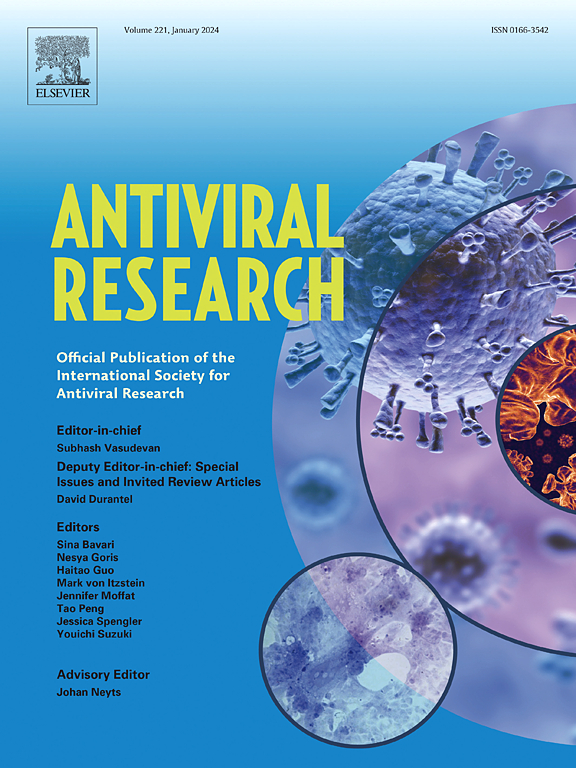High-throughput screening for identification of influenza a inhibitors using a cell-based immunofluorescence assay
IF 4.5
2区 医学
Q1 PHARMACOLOGY & PHARMACY
引用次数: 0
Abstract
A highly sensitive cell-based imaging assay has been used to screen a 200,000 compounds library for potential influenza antivirals. Compounds were screened at a concentration of 10 μM against the influenza strain A/Udorn/72 (H3N2) and the duplex capability of the assay was taken advantage of to select compounds with no or low cytotoxicity. The assay was also used for confirmation in concentration-response of the active compounds. In the set of confirmed hits, three major structural clusters, 23 minor clusters and 86 singletons were identified. Further evaluation of anti-influenza activity was performed for two additional influenza strains of the H1N1 subtype, A/WSN/33 and A/California/07/09. Three compounds from cluster A, SRI-44211, SRI-44215 and SRI-44221 showed selectivity indices for the pandemic strain A/California/07/09 in the range of 54.3–252, providing evidence that the core structure of cluster A could play a relevant role in their inhibitory potency and may serve as a starting point for future hit-to-lead optimization efforts.
利用基于细胞的免疫荧光法对甲型流感抑制剂进行高通量筛选。
一种高度敏感的基于细胞的成像试验已被用于筛选20万种化合物库中潜在的流感抗病毒药物。化合物在10 μM浓度下对流感菌株a /Udorn/72 (H3N2)进行了筛选,并利用该方法的双相能力筛选出了无细胞毒性或低细胞毒性的化合物。该方法还用于验证活性化合物的浓度响应。在确定的命中点中,鉴定出3个主要结构簇,23个次要簇和86个单子。对另外两个H1N1亚型流感毒株A/WSN/33和A/California/07/09进行了进一步的抗流感活性评估。聚类A中的3个化合物,SRI-44211、SRI-44215和SRI-44221对大流行毒株A/California/07/09的选择性指数在54.3 ~ 252之间,这表明聚类A的核心结构可能与它们的抑制效力有关,并可能为未来的hit-to-lead优化工作提供起点。
本文章由计算机程序翻译,如有差异,请以英文原文为准。
求助全文
约1分钟内获得全文
求助全文
来源期刊

Antiviral research
医学-病毒学
CiteScore
17.10
自引率
3.90%
发文量
157
审稿时长
34 days
期刊介绍:
Antiviral Research is a journal that focuses on various aspects of controlling viral infections in both humans and animals. It is a platform for publishing research reports, short communications, review articles, and commentaries. The journal covers a wide range of topics including antiviral drugs, antibodies, and host-response modifiers. These topics encompass their synthesis, in vitro and in vivo testing, as well as mechanisms of action. Additionally, the journal also publishes studies on the development of new or improved vaccines against viral infections in humans. It delves into assessing the safety of drugs and vaccines, tracking the evolution of drug or vaccine-resistant viruses, and developing effective countermeasures. Another area of interest includes the identification and validation of new drug targets. The journal further explores laboratory animal models of viral diseases, investigates the pathogenesis of viral diseases, and examines the mechanisms by which viruses avoid host immune responses.
 求助内容:
求助内容: 应助结果提醒方式:
应助结果提醒方式:


